How Long Can The Fed Fight The Tide?
As a plurality of economic reports showed that the
US was strongly recovering, the world was in the middle of a
recovery, Japan continued to add jobs, and even Europe actually showed some
growth over the latest quarter, global bond prices began to head lower.
Australia and the UK raised rates. Gilts made new lows. If it developed, a sharp
decline in global bonds with a plurality of new lows would begin to worry the
markets as it would mean long-term rates were headed quite a bit higher in
response to burgeoning global growth.
But just as global stocks began to turn down in response to concerns about
falling bond markets, the Fed had various Fed members blitzkrieg the
press with stories about how it would still be a very long time before the Fed
even thought about raising short-term rates. US bonds soared, and global bonds
have reluctantly followed. Global stock markets are recovering in response. This
jawboning session has clearly bought the markets and the recovery time before
long-rate rises become problematic. But just how long the Fed can fight the tide
of rising bond rates with jawboning remains to be seen. And how long global
stock markets can continue to rally may well depend on how orderly the
inevitable decline in long-term bond prices is, as the recovery gathers steam.
Investors should definitely stay tuned.
After a flurry of negative news in the Iraq war, Bush convened a war counsel
that appears to have led to the launching of a new offensive, Operation Iron
Hammer. It appears the new strategy is a broad and harsh offensive on the Sunni
triangle in an attempt to eliminate enough of the guerrillas to severely hamper
their operations. During the lull in guerrilla activity, it appears Bush wants
to hand over power to the Iraqis. The peak in the guerrilla activity led to a
broad decline in the dollar. It remains to be seen how successful this strategy
will be.
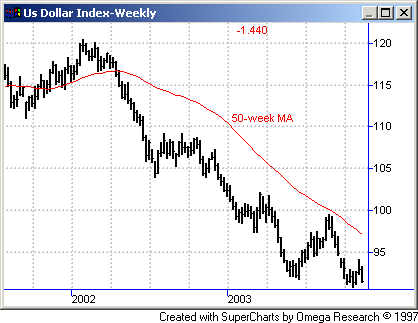
In the meantime, with brief dollar strength from strong economic news giving way
to deterioration in Iraq and a slide in international support for supplying
suicide troops, gold has inched to new highs. It may still have trouble with the
400 level, but is moving higher along with commodity prices and led by junior
mining shares. While many observers are becoming worried that higher bond prices
and some tightening overtures in China will temporarily halt the bull move in
raw industrial commodities, investors should realize that this is the first
synchronous global recovery ever where China was a huge net importer of raw
commodities, and this move likely has a long way to go, although it is getting
short-term overdone. PSPFX and other commodity plays are doing well, and the
CRB futures we suggested investors buy a few weeks back have
now made new highs. The move in commodities is likely to be more durable and
less prone to manipulation than the bear market in global bond prices. And
investors still need to watch the dollar carefully. Although
the dollar is likely to be somewhat stable as long as economic reports show
strong growth in the US, a serious slide in the dollar against the euro and not
just commodity currencies, could hit bonds and eventually stocks.
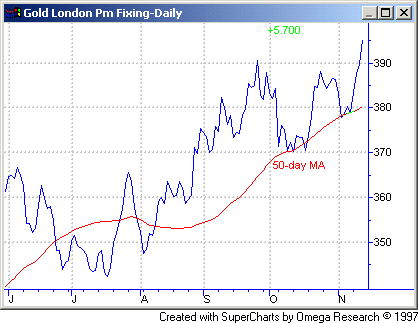
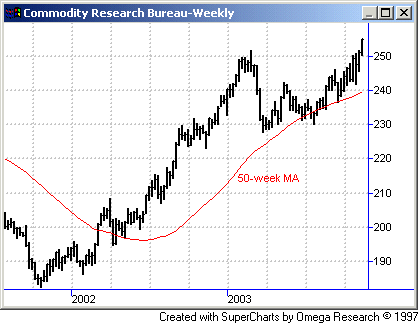
Investors should realize though that the seeds of the demise of this recovery
have likely already been sown in the form of massive reflation on both a
monetary and fiscal basis globally. Unlike other recoveries, in this one we
suggest investors get less bullish as the markets move higher, not more bullish.
As long as the US market holds above last month’s lows, the global leaders are
likely to hang on in with outperformance: Asia and broad EMs, Eastern Europe,
Latin America, and especially resource, base metal and junior mining shares. But
gains here have averaged over 40% since the March lows, and investors should be
ready to take some partial profits on the first sign of weakness in developed
markets. The main trend continues to be up for both US and global equities, but
things are overdone in most markets and they are therefore vulnerable to
setbacks at any time.
Our US long/short model is doing reasonable well considering the low level of
allocation it has had. We have long encouraged investors to supplement this
strategy with or favorite foreign and global asset plays. Investors should
continue to cautiously add stock exposure as trade signals are generated that
meet our strict criteria, as well as allocate to our favorite segments. Our
model portfolio followed in TradingMarkets.com with specific entry/exit/ops
levels from 1999 through May of 2003 was up 41% in 1999, 82% in 2000, 16.5% in
2001, 7.58% in 2002, and we stopped specific recommendations up around 5% in May
2003 (strict following of our US only methodologies should have portfolios up
over 11% ytd by our calculations) — all on worst drawdown of under 7%.
Last week in our Top RS/EPS New Highs list published on
TradingMarkets.com, we had readings of 74, 68, 37, 16, and 38, accompanied by 8
breakouts of 4+ week ranges, no valid trades and close calls in APSG, EENC, and
NITE. Internal strength is deteriorating and we have been stopped out of all the
longs purchased since the March recovery began. A burst of new highs accompanied
by a handful of valid trades will be required to put us back into the US growth
market via our long/short strategy, though it is worth noting that the short
side has not given us any real opportunities yet. Continue to position in valid
4 week trading range breakouts on stocks meeting our criteria or in close calls
that are in clearly leading industries, in a diversified fashion. Bottom
RS/EPS New Lows remained non-existent with readings of 2, 2, 1, 0, and
3 with one breakdown of a 4+ week range, no valid trades and no close calls. The
short-side remains bleak.
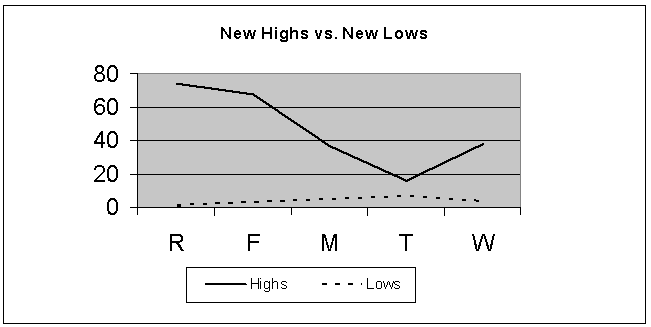
For those not familiar with our long/short strategies, we suggest you review my
book The Hedge Fund Edge, my course “The Science of
Trading,” my video seminar, where I discuss many new techniques, and my
latest educational product, the interactive training module. Basically, we have
rigorous criteria for potential long stocks that we call “up-fuel,” as well as
rigorous criteria for potential short stocks that we call “down-fuel.” Each day
we review the list of new highs on our “Top RS and EPS New High List”
published on TradingMarkets.com for breakouts of four-week or longer flags, or
of valid cup-and-handles of more than four weeks. Buy trades are taken only on
valid breakouts of stocks that also meet our up-fuel criteria.
Shorts are similarly taken only in stocks meeting our down-fuel criteria that
have valid breakdowns of four-plus-week flags or cup and handles on the
downside. In the US market, continue to only buy or short stocks in leading or
lagging industries according to our group and sub-group new high and low lists.
We continue to buy new long signals and sell short new short signals until our
portfolio is 100% long and 100% short (less aggressive investors stop at 50%
long and 50% short). In early March of 2000, we took half-profits on nearly all
positions and lightened up considerably as a sea change in the
new-economy/old-economy theme appeared to be upon us. We’ve been effectively
defensive ever since.
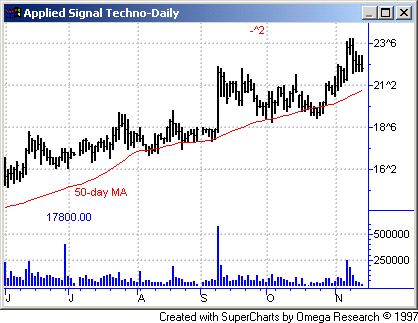
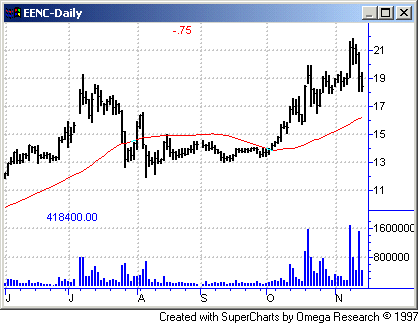
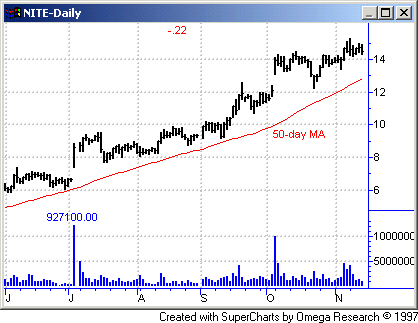
On the long side, we like the close calls from this week, (APSG),
(EENC),
and (NITE),
and recent close calls from past weeks, (NIHD),
(PETD),
(STFC),
(FDRY),
(WR)
and (FCX),
as well as in our favorite global sectors. We also like broad metal
stocks like FCX, small-cap Emerging Markets in
general, metals and resources, South Africa, broad
Latin America, and broad Eastern Europe (on a good
upside reversal on high volume) and broad Asia. But use tight
stops in all of these plays as the upside party is well established and a bit
overdone.
At the risk of sounding like Professor Moody in Book 4 of the Harry
Potter series — we still strongly suggest that investors “stay vigilant
at all times!†We still believe that we’ll have to be very nimble to profit
consistently and know when to pull the plug in this market, and when to time the
hiccups. A mini-mania could develop if global economic statistics start to
change investor psychology — or a shock could tank this market so quickly it
would make you dizzy. We’re probably going to experience a 10%+ correction as
the market transitions from liquidity to growth as its fuel at some point.
That’s why we suggest using funds and vehicles that are liquid enough to get in
and out of quickly for our current exposure to top relative strength markets.
Investors are advised to remain extremely flexible.
Until next week,
Mark Boucher
